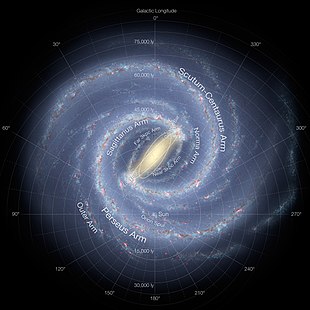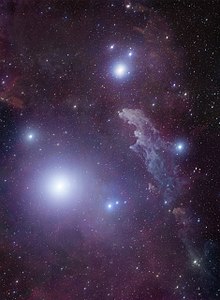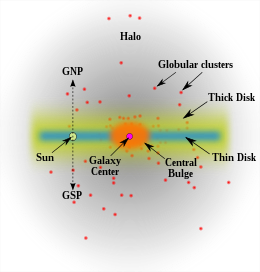Stellar population

In 1944, Walter Baade categorized groups of stars within the Milky Way into stellar populations. In the abstract of the article by Baade, he recognizes that Jan Oort originally conceived this type of classification in 1926.[1]
Baade observed that bluer stars were strongly associated with the spiral arms, and yellow stars dominated near the central
Among the population types, significant differences were found with their individual observed stellar spectra. These were later shown to be very important and were possibly related to star formation, observed kinematics,[3] stellar age, and even galaxy evolution in both spiral and elliptical galaxies. These three simple population classes usefully divided stars by their chemical composition or metallicity.[4][5][3]
By definition, each population group shows the trend where decreasing metal content indicates increasing age of stars. Hence, the first stars in the universe (very low metal content) were deemed population III, old stars (low metallicity) as population II, and recent stars (high metallicity) as population I.
Stellar development
Observation of stellar spectra has revealed that stars older than the Sun have fewer heavy elements compared with the Sun.[3] This immediately suggests that metallicity has evolved through the generations of stars by the process of stellar nucleosynthesis.
Formation of the first stars
Under current cosmological models, all matter created in the Big Bang was mostly hydrogen (75%) and helium (25%), with only a very tiny fraction consisting of other light elements such as lithium and beryllium.[8] When the universe had cooled sufficiently, the first stars were born as population III stars, without any contaminating heavier metals. This is postulated to have affected their structure so that their stellar masses became hundreds of times more than that of the Sun. In turn, these massive stars also evolved very quickly, and their nucleosynthetic processes created the first 26 elements (up to iron in the periodic table).[9]
Many theoretical stellar models show that most high-mass population III stars rapidly exhausted their fuel and likely exploded in extremely energetic pair-instability supernovae. Those explosions would have thoroughly dispersed their material, ejecting metals into the interstellar medium (ISM), to be incorporated into the later generations of stars. Their destruction suggests that no galactic high-mass population III stars should be observable.[10] However, some population III stars might be seen in high-redshift galaxies whose light originated during the earlier history of the universe.[11] Scientists have found evidence of an extremely small ultra metal-poor star, slightly smaller than the Sun, found in a binary system of the spiral arms in the Milky Way. The discovery opens up the possibility of observing even older stars.[12]
Stars too massive to produce pair-instability supernovae would have likely collapsed into
Formation of the observed stars
The oldest stars observed thus far,[10] known as population II, have very low metallicities;[16][6] as subsequent generations of stars were born, they became more metal-enriched, as the gaseous clouds from which they formed received the metal-rich dust manufactured by previous generations of stars from population III.
As those population II stars died, they returned metal-enriched material to the interstellar medium via planetary nebulae and supernovae, enriching further the nebulae, out of which the newer stars formed. These youngest stars, including the Sun, therefore have the highest metal content, and are known as population I stars.
Chemical classification by Baade
Population I stars

Population I, or metal-rich, stars are young stars with the highest metallicity out of all three populations and are more commonly found in the
Population I stars usually have regular
Population II stars


Population II, or metal-poor, stars are those with relatively little of the elements heavier than helium. These objects were formed during an earlier time of the universe. Intermediate population II stars are common in the
A characteristic of population II stars is that despite their lower overall metallicity, they often have a higher ratio of "
Scientists have targeted these oldest stars in several different surveys, including the HK objective-prism survey of
Population III stars

Population III stars[24] are a hypothetical population of extremely massive, luminous and hot stars with virtually no "metals", except possibly for intermixing ejecta from other nearby, early population III supernovae. The term was first introduced by Neville J. Woolf in 1965.[25][26] Such stars are likely to have existed in the very early universe (i.e., at high redshift) and may have started the production of chemical elements heavier than hydrogen, which are needed for the later formation of planets and life as we know it.[27][28]
The existence of population III stars is inferred from

Current theory is divided on whether the first stars were very massive or not. One possibility is that these stars were much larger than current stars: several hundred solar masses, and possibly up to 1,000 solar masses. Such stars would be very short-lived and last only 2–5 million years.[32] Such large stars may have been possible due to the lack of heavy elements and a much warmer interstellar medium from the Big Bang.[citation needed] Conversely, theories proposed in 2009 and 2011 suggest that the first star groups might have consisted of a massive star surrounded by several smaller stars.[33][34][35] The smaller stars, if they remained in the birth cluster, would accumulate more gas and could not survive to the present day, but a 2017 study concluded that if a star of 0.8 solar masses (M☉) or less was ejected from its birth cluster before it accumulated more mass, it could survive to the present day, possibly even in our Milky Way galaxy.[36]
Analysis of data of extremely low-
Population II stars are considered seeds of black holes in the early universe but unlike high-mass black hole seeds like direct collapse black holes they would have produced light ones, if they could have grown to larger than expected masses then they could have been quasi-stars, other hypothetical seeds of heavy black holes which would have existed in the early development of the Universe before hydrogen and helium were contaminated by heavier elements.
Detection of population III stars is a goal of NASA's
On 8 December 2022, astronomers reported the possible detection of Population III stars.[44][45]
See also
Notes
- interstellar matter. Past supernovae in these small galaxies could have ejected their metal-rich contents at speeds high enough for them to escape the galaxy, keeping the small galaxies' metal content very low.[15]
References
- ^
doi:10.1086/144650.
The two types of stellar populations had been recognized among the stars of our own galaxy by Oort as early as 1926.
- ^
ISBN 978-0674340510– via Archive.org.
- ^ S2CID 12253299. Archived from the original(PDF) on 20 January 2021. Retrieved 17 April 2018.
- ^
Kunth, Daniel & Östlin, Göran (2000). "The most metal-poor galaxies". S2CID 15487742. Retrieved 3 January 2022 – via caltech.edu.
- .
- ^ a b Bryant, Lauren J. "What makes stars tick". Research & Creative Activity. Indiana University. Archived from the original on May 16, 2016. Retrieved September 7, 2005.
- ^ "Metals". astronomy.swin.edu.au. Cosmos. Retrieved 2022-04-01.
- ^
Cyburt, Richard H.; Fields, Brian D.; Olive, Keith A.; Yeh, Tsung-Han (2016). "Big bang nucleosynthesis: Present status". S2CID 118409603.
- ^ a b
Heger, A.; Woosley, S.E. (2002). "The nucleosynthetic signature of Population III". S2CID 16050642.
- ^ a b
Schlaufman, Kevin C.; Thompson, Ian B.; Casey, Andrew R. (2018). "An ultra metal-poor star near the hydrogen-burning Limit". The Astrophysical Journal. 867 (2): 98. S2CID 54511945.
- S2CID 118303030.
- ^ "One of Milky Way's oldest stars discovered". Sci-News. 6 November 2018. Retrieved 12 June 2020.
- ^
Fryer, C. L.; Woosley, S. E.; Heger, A. (2001). "Pair-instability supernovae, gravity waves, and gamma-ray transients". The Astrophysical Journal. 550 (1): 372–382. S2CID 7368009.
- ^
Heger, A.; Fryer, C. L.; Woosley, S. E.; Langer, N.; Hartmann, D. H. (2003). "How massive single stars end their life". The Astrophysical Journal. 591 (1): 288–300. S2CID 59065632.
- ^ Clark, Stuart (February 2010). "Primordial giant: The star that time forgot". New Scientist. Retrieved 1 February 2015.
- ^ a b
Salvaterra, R.; Ferrara, A.; S2CID 15085880.
- ^
Soriano, M.S.; Vauclair, S. (2009). "New seismic analysis of the exoplanet-host star Mu Arae". Astronomy and Astrophysics. 513: A49. S2CID 5688996.
- ^
Lineweaver, Charles H. (2000). "An estimate of the age distribution of terrestrial planets in the universe: Quantifying metallicity as a selection effect". Icarus. 151 (2): 307–313. S2CID 14077895.
- ^
Buchhave, L.A.; et al. (2012). "An abundance of small exoplanets around stars with a wide range of metallicities". S2CID 4427321.
- ^
van Albada, T. S.; Baker, N. (1973). "On the two Oosterhoff groups of globular clusters". doi:10.1086/152434.
- ^
Wolfe, Arthur M.; Gawiser, Eric; Prochaska, Jason X. (2005). "Damped Ly‑α systems". Annual Review of Astronomy and Astrophysics. 43 (1): 861–918. S2CID 119368187.
- S2CID 121564385.
- arXiv:astro-ph/9810183v1.
- ^
Tominga, N.; et al. (2007). "Supernova nucleosynthesis in population III 13-50 Msolar stars and abundance patterns of extremely metal-poor stars". S2CID 119496577.
- Bibcode:1966S&T....31..199G.
- PMID 17817304.
- ^ a b
Sobral, David; Matthee, Jorryt; Darvish, Behnam; Schaerer, Daniel; Mobasher, Bahram; Röttgering, Huub J.A.; Santos, Sérgio; Hemmati, Shoubaneh (4 June 2015). "Evidence for Pop III-like stellar populations in the most luminous Lyman-α emitters at the epoch of re-ionisation: Spectroscopic confirmation". S2CID 18471887.
- ^ Overbye, Dennis (17 June 2015). "Astronomers report finding earliest stars that enriched the cosmos". The New York Times. Retrieved 17 June 2015.
- ^
Fosbury, R.A.E.; et al. (2003). "Massive star formation in a gravitationally lensed H II galaxy at z = 3.357". S2CID 17808828.
- ^
"Best observational evidence of first-generation stars in the universe". Astronomy Magazine. 17 June 2015.
- ^
Bromm, V.; Yoshida, N.; Hernquist, L.; McKee, C.F. (2009). "The formation of the first stars and galaxies". S2CID 10258026.
- ^
Ohkubo, Takuya; Nomoto, Ken'ichi; Umeda, Hideyuki; Yoshida, Naoki; Tsuruta, Sachiko (2009-12-01). "Evolution of very massive Population III stars with mass accretion from pre-main sequence to collapse". ISSN 0004-637X.
- ^ Redd, Nola (February 2011). "The universe's first stars weren't loners after all". Space.com. Retrieved 1 February 2015.
- ^ Thompson, Andrea (January 2009). "How massive stars form: Simple solution found". Space.com. Retrieved 1 February 2015.
- ^ Carr, Bernard J. "Cosmology, Population III". California Institute of Technology.
- ^
Dutta, J.; Sur, S.; Stacy, A.; Bagla, J.S. (2020). "Modeling the Survival of Population III Stars to the Present Day". The Astrophysical Journal. 901 (1): 16. S2CID 209386374.
- ^
Umeda, Hideyuki; Nomoto, Ken'Ichi (2003). "First-generation black-hole-forming supernovae and the metal abundance pattern of a very iron-poor star". S2CID 4424736.
- ^
Puzia, Thomas H.; Kissler-Patig, Markus; Goudfrooij, Paul (2006). "Extremely α-enriched globular clusters in early-type galaxies: A step toward the dawn of stellar populations?". S2CID 9815509.
- ^
Siess, Lionel; Livio, Mario; Lattanzio, John (2002). "Structure, evolution, and nucleosynthesis of primordial stars". S2CID 18385975.
- Bibcode:2013JCos...2210163G.
- ^
Kerins, E.J. (1997). "Zero-metallicity very low mass stars as halo dark matter". Bibcode:1997A&A...322..709K.
- ^
Sanchez-Salcedo, F.J. (1997). "On the stringent constraint on massive dark clusters in the galactic halo". Astrophysical Journal Letters. 487 (1): L61. doi:10.1086/310873.
- ^ Rydberg, C.-E.; Zackrisson, E.; Lundqvist, P.; Scott, P. (March 2013). "Detection of isolated population III stars with the James Webb Space Telescope". .
- arXiv:2212.04476 [astro-ph.GA].
- ^ Callaghan, Jonathan (30 January 2023). "Astronomers Say They Have Spotted the Universe's First Stars - Theory has it that "Population III" stars brought light to the cosmos. The James Webb Space Telescope may have just glimpsed them". Quanta Magazine. Retrieved 31 January 2023.
Further reading
- Gibson, B. K.; et al. (2013). "Review: Galactic Chemical Evolution" (PDF). Publications of the Astronomical Society of Australia. Archived from the original (PDF) on 20 January 2021. Retrieved 17 April 2018.
- Ferris, Timothy (1988). Coming of Age in the Milky Way. ISBN 978-0-688-05889-0.
- Kippenhahn, Rudolf (1993). 100 Billion Suns: The birth, life, and death of the stars. Princeton University Press. ISBN 978-0-691-08781-8– via Google Books.
